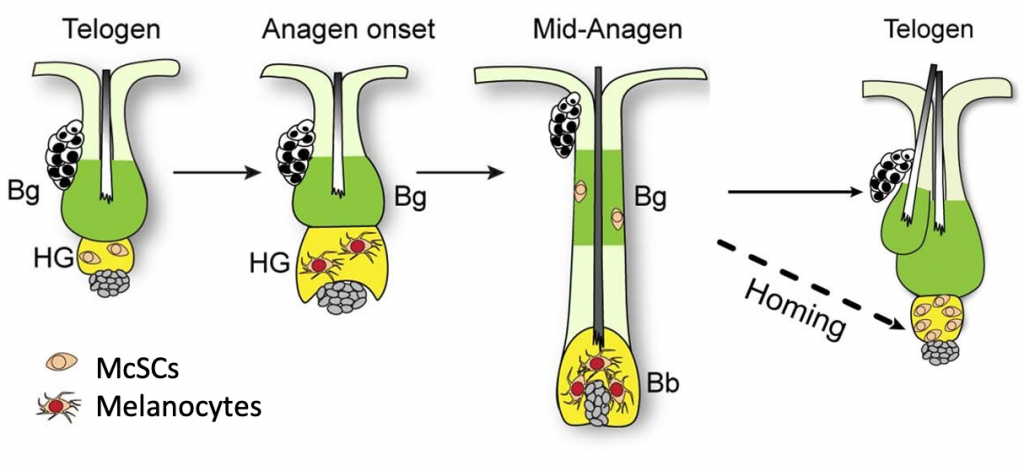Key Points:
- Pigment stem cells — responsible for hair coloration — become trapped in hair follicles, hindering them from coloring hair.
- Repeatedly removing hair at the skin’s surface — depilation — leads to accelerated accumulation of trapped stem cells and hair graying.
- Plucking hair repeatedly also increases the accumulation of trapped pigment stem cells within hair follicles.
Like other tissues, our hair depends largely on stem cells to regenerate. However, with aging our stem cells dwindle in number and lose their function. Accordingly, the age-related decline in pigment stem cells — melanocyte stem cells (McSCs) — leads to hair graying. However, the nature of McSC decline has not been well understood until now.
Researchers from New York University (NYU) report in Nature that McSCs migrate up and down hair follicles to maintain their function. However, over repeated migrations, they get stuck in the upper hair follicle, unable to migrate back to the area where they can regenerate more cells. Sun and colleagues show that this process is accelerated with depilation and plucking during the resting phase of hair growth, suggesting that such hair removal methods can lead to premature hair graying.
Trapped Stem Cells Lead to Hair Graying
Using sophisticated imaging techniques and genetically modified mice, Sun and colleagues tracked the movement of McSCs along hair follicles during hair growth. They found that contrary to previous evidence, most McSCs reside in a region called the hair germ (HG) near the bottom of the hair follicle, at least during the non-growth phase (telogen phase).
During the growth phase (anagen phase), McSCs give rise to pigment-producing cells called melanocytes. Melanocytes produce melanin, the pigment that gives hair its color. The NYU researchers found that while some McSCs give rise to melanocytes in the HG during the growth phase others travel up the hair follicle to a region called the bulge (Bg), escaping their fate as melanocytes. After the hair has grown, the McSCs in the Bg travel back to the HG to start the next cycle.

By traveling to the Bg, MsSCs avoid the signaling factors that turn them into melanocytes. They can then replicate to maintain a pool of McSCs in the HG and produce more melanocytes for future hair growth. However, this system isn’t perfect, and the researchers noticed that not all McSCs go back to the HG but remain in the Bg. Since the McSCs trapped in the Bg can no longer contribute to melanocyte production, hair graying ensues.
Removing Hair May Accelerate Hair Graying
To experimentally accelerate hair follicle aging, Sun and colleagues performed repeated depilation of mice at every telogen phase starting from a young age (3-weeks-old). By the seventh telogen phase the percentage of McSCs trapped in the Bg increased from 10% to more than 50%. Furthemore, McSCs in the HG were depleted and the hair of the mice turned gray.

The method by which Sun and colleagues removed (depilated) the mouse fur was not specified in their report but could range from chemical hair removal with products like Nair or mechanical removal like shaving. The researchers also tested whether plucking hair had a similar effect to depilation. To do this, they plucked the hair of mice during the second, third, and fourth telogen phase then let the mice age for eight months. The results showed that plucking had a similar effect to depilation with a higher percentage of McSCs located in the Bg rather than the HG.

Overall, the findings of Sun and colleagues show that some McSCs travel to the Bg during hair growth to avoid becoming melanocytes. At the same time, other McSCs stay in the HG during hair growth to become melanocytes and contribute to hair color. The McSCs in the Bg then travel back to the HG to replenish the McSC pool for the next cycle. However, with hair follicle aging, the McSCs get trapped in the Bg and never make it back to the HG. Without McSCs in the HG, melanocytes cannot be generated, and hair color is lost.
Rejuvenating Hair Color
At any given time, 10-15% of our hair follicles are in the telogen phase where they can remain for up to a year on the scalp. Repeatedly depilating or plucking hairs during the telogen phase could hypothetically accelerate hair graying based on Sun and colleagues’ findings. However, other factors can contribute to hair graying, and human studies on this effect have not been conducted.
There is also the possibility that hair color could be rejuvenated by finding a way to move McSCs trapped in the Bg back to the HG in individuals with gray hairs.
“Our study adds to our basic understanding of how melanocyte stem cells work to colour hair,” said the lead investigator Dr Qi Sun. “The newfound mechanisms raise the possibility that the same fixed-positioning of melanocyte stem cells may exist in humans. If so, it presents a potential pathway for reversing or preventing the greying.”